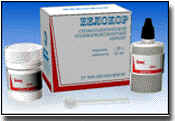A Policarboxylate Cement

| Belocor A Policarboxylate Cement |
 |
PURPOSE
The BELOCOR policarboxylate cement is used for fixing inserts, different types of crowns, small dental bridges, and orthodontic instruments as well as for filling the teeth. It is also used as provisional fillings or pads, which are to be covered with constant fillings made of amalgam, gallodent, plastics and silicate cement.
The BELOCOR policarboxylate cement is formed by mixing a powder containing zinc oxide with modified agents and a liquid represented by the water solution of the poliacrylic acid. The peculiarity of the BELOCOR is its adhesive quality and less solubility in the oral cavity, which makes it different from the zinc-phosphate cements. The liquid in the cement doesn’t irritate the tooth pulp. The policarboxylate cement causes no pain, which is likely to appear at fixing the stationary dentures with zinc-phosphate cements.
MODE OF USE
The carious cavity should be prepared correctly and its edges should be ground then for good fitting of the filling. The retentive posts should be placed on the walls of clean and dry carious cavity. When mixing, the glass plate and the spatula are used. Directly before mixing, the liquid is dosed out on the plate by means of a flask-dropper. The powder and the liquid should be mixed immediately, the mixing time should not exceed 20-30 seconds. The powder should be divided into two parts: during 15 seconds one half of the powder measured is mixed with the liquid, during the following 15 seconds - the remaining part until a homogeneous mass is obtained. The dough should be used till it has glossy surface (during 2 minutes). For fixing inserts and different types of stationary dentures, the normal consistency of the cement dough is achieved by mixing 2 measuring spoons of the powder (0,5g) with 8-10 drops of the liquid (0,35g). The policarboxylate cement has a denser consistency than zinc-phosphate cements.For filling the teeth, for putting the provisional fillings and pads under other filling materials, the normal consistency of the cement dough is achieved by mixing 2 measuring spoons of the powder (0,5g) with 5-7 drops of the liquid (0,25g). The temperature exceeding +22oC, less powder should be used or more liquid should be added. The surplus of the cement should be removed before its hardening. The final treatment should be done in 8-10 minutes after filling with an abrasive instrument.
PACKAGE
Powder.................... 20g
Liquid..................... 12ml
STORAGE CONDITIONS
Keep in dry dark place, in tightly closed containers, at a temperature of +4oC to +25oC.ANALOGUES:
CARBOPHAINE (“Spopha-Dental”, Czechia)
The policarboxylate cement (“Stoma”, Ukraine)
“Carboco” (“Voco”, Germany)
“Selfast” (“Septodont”, France)
“PolyCarb” (“PSP Dental”, England)
“PR Scell Policarboxylate” (“Pierre Rolland”, France)